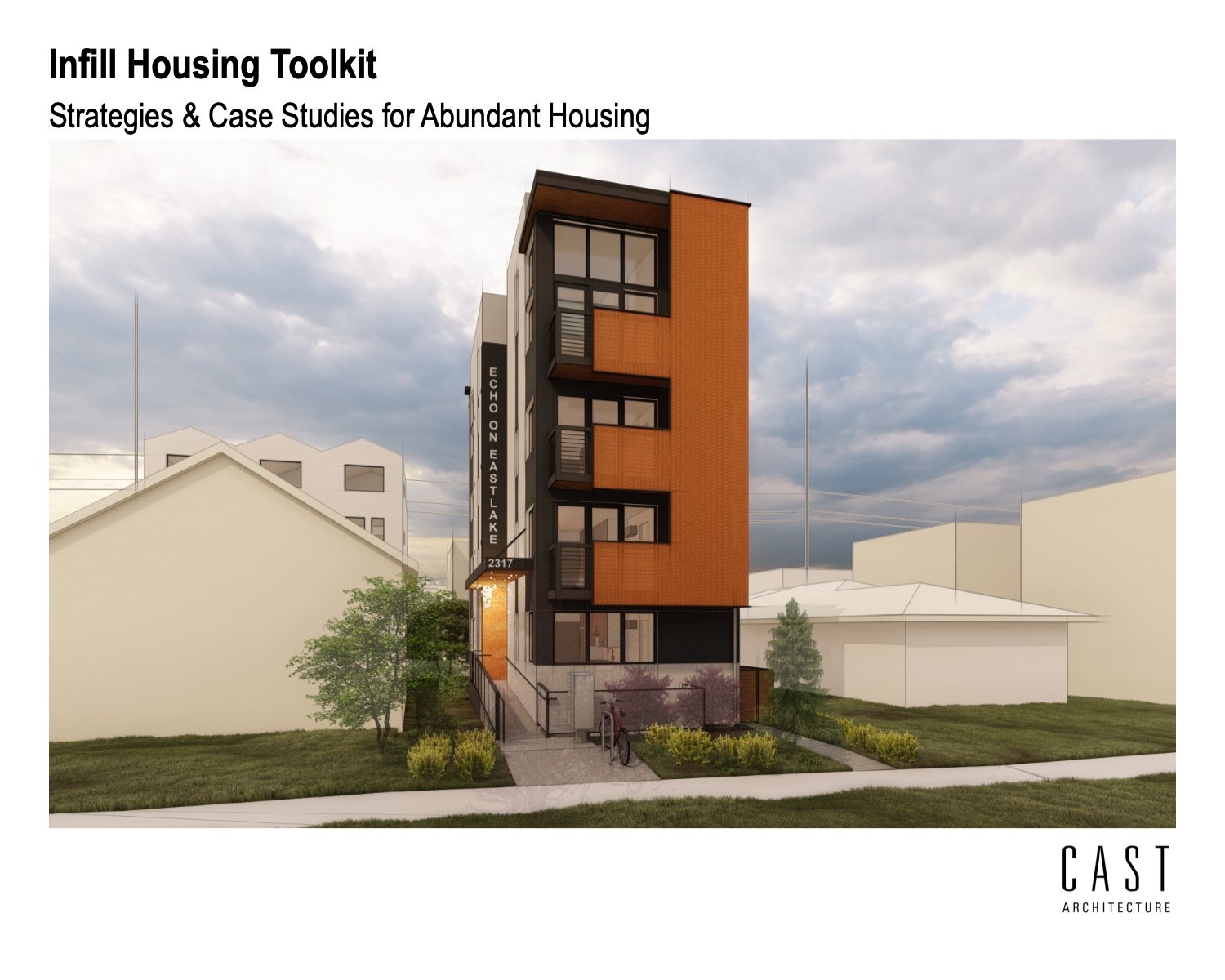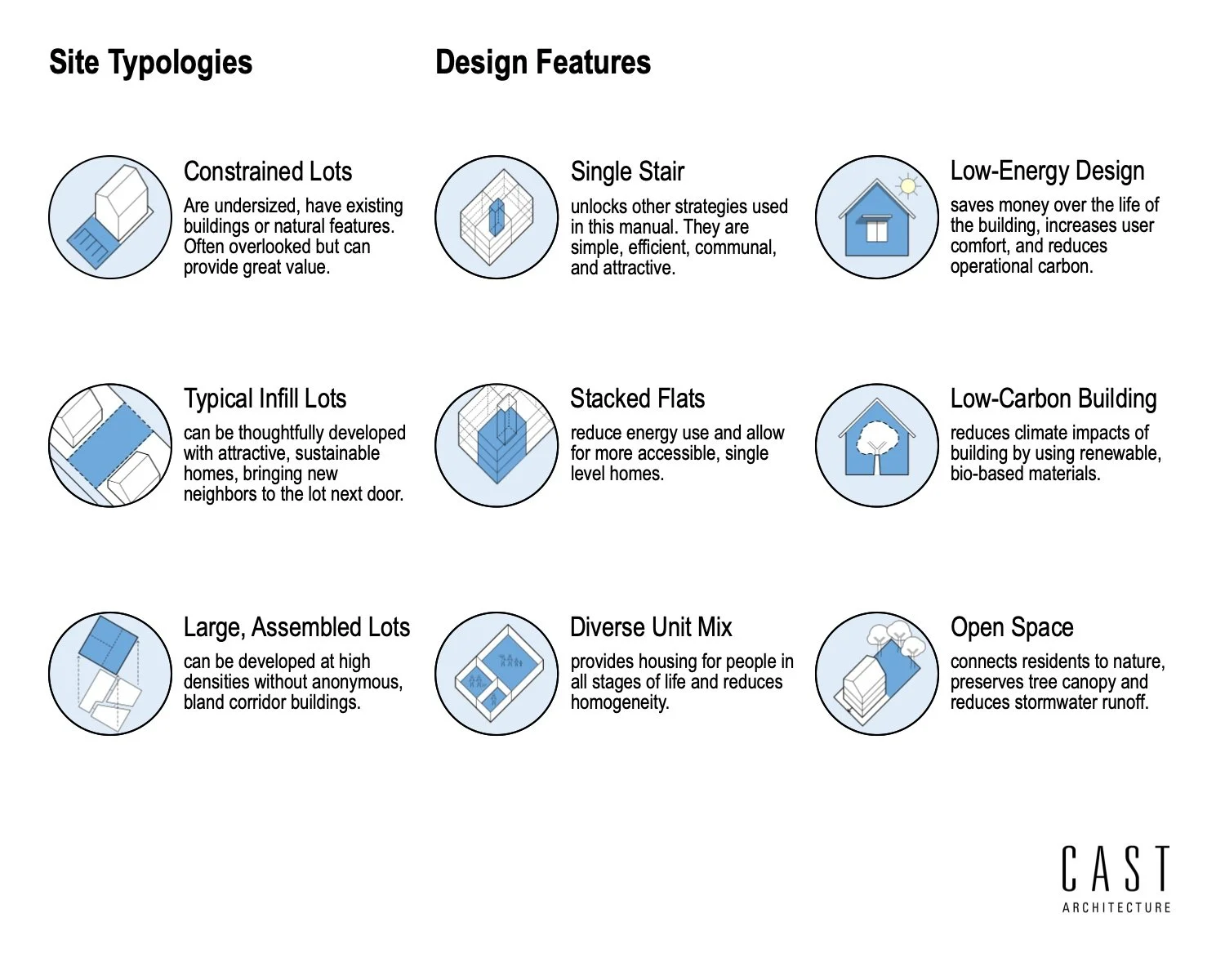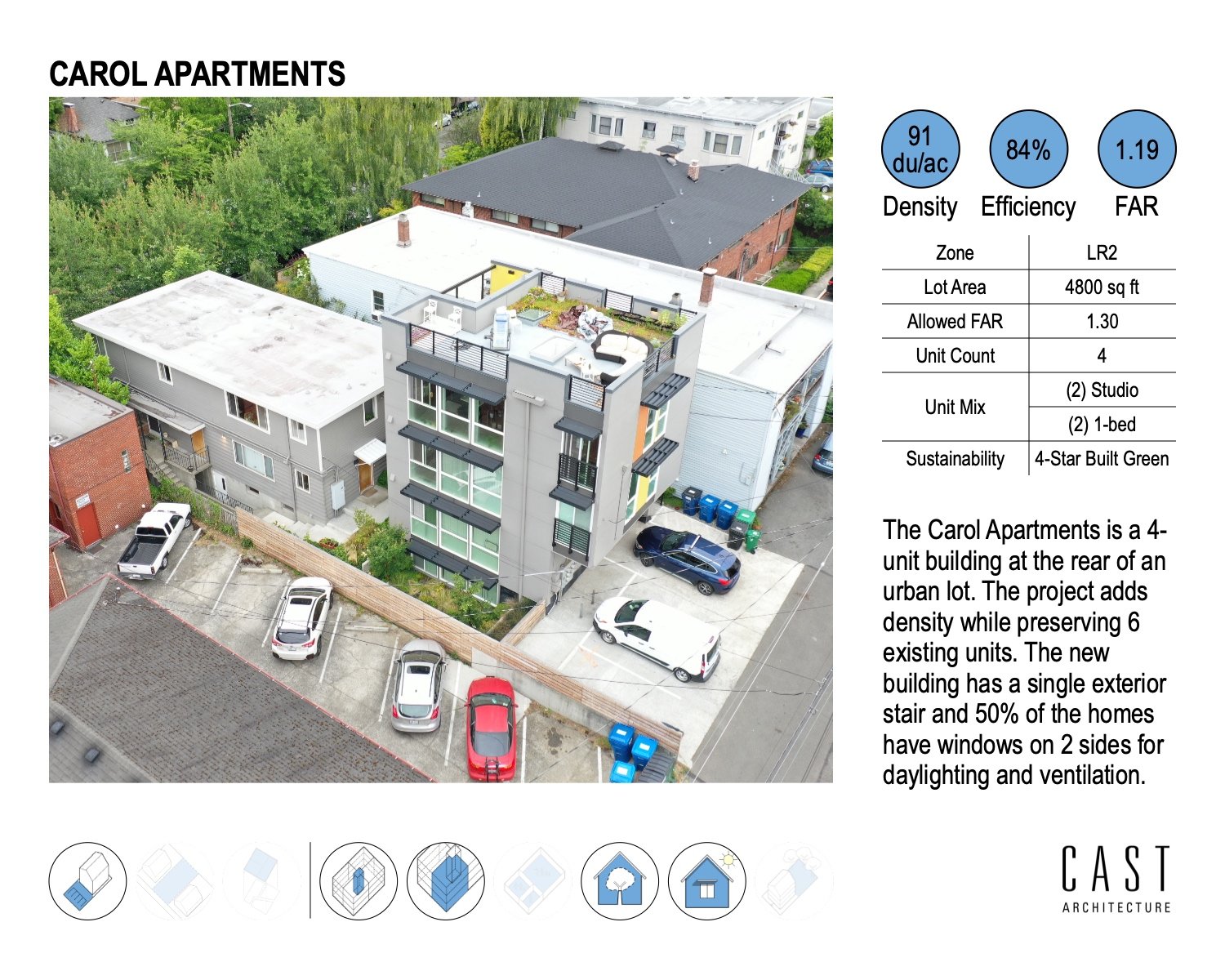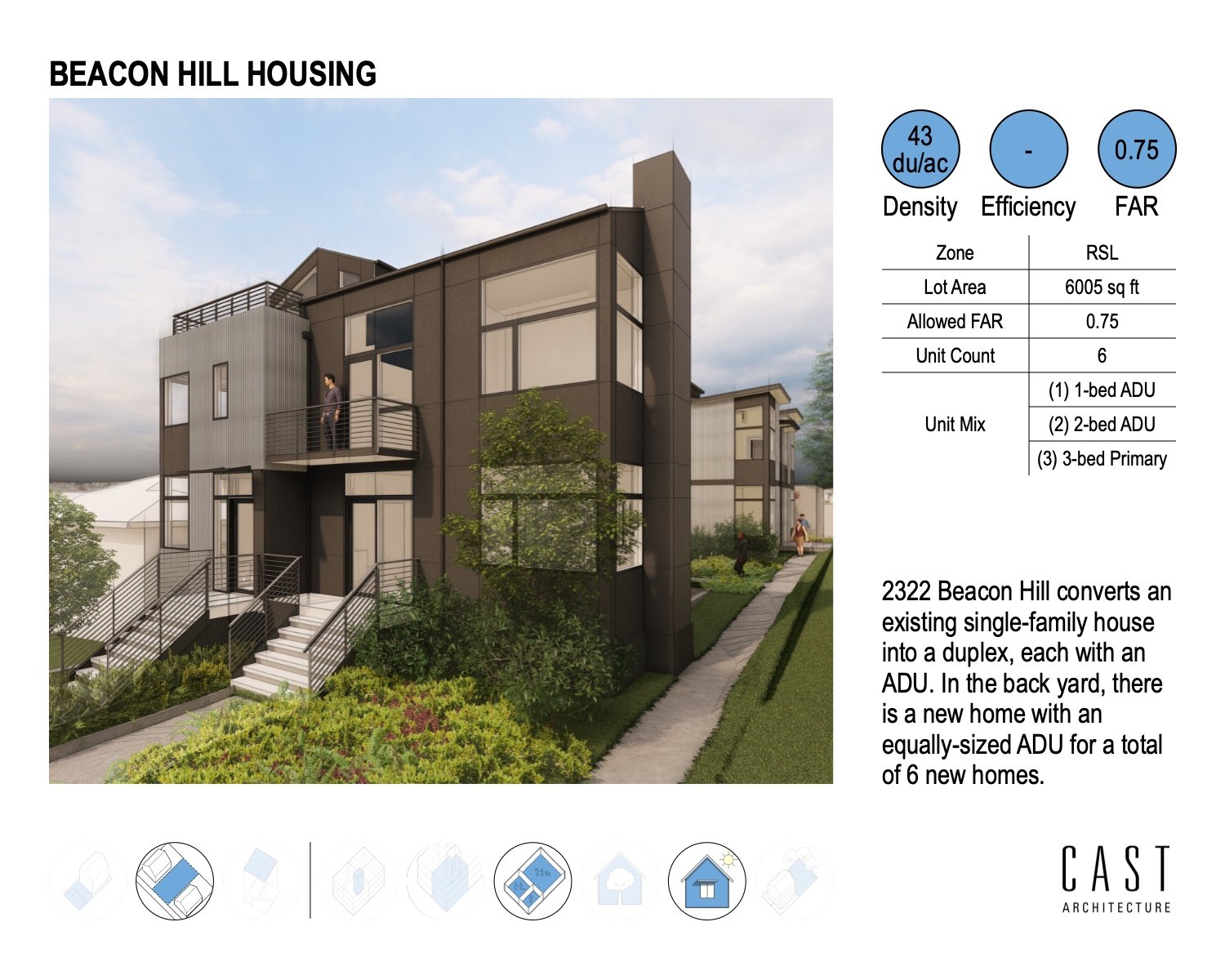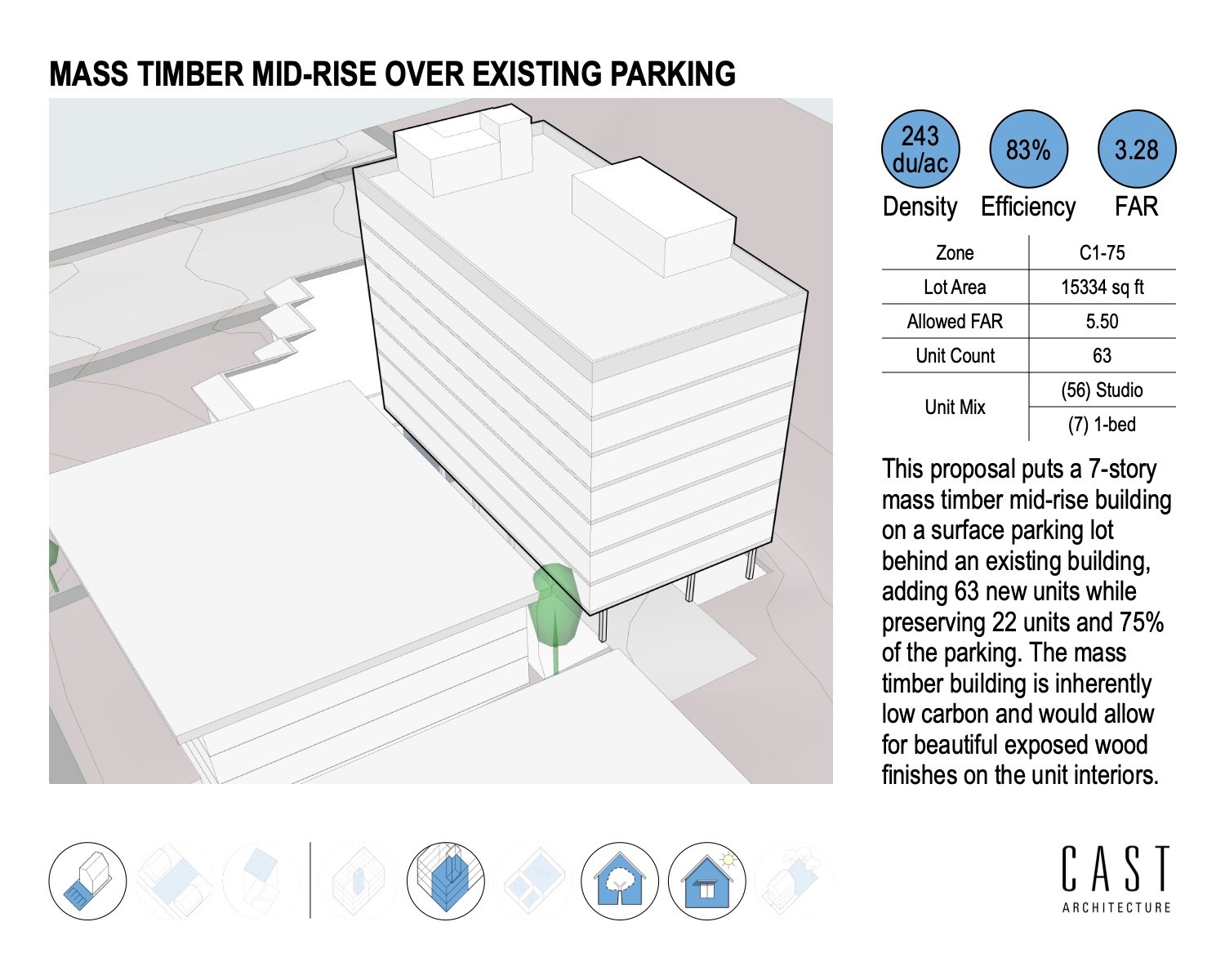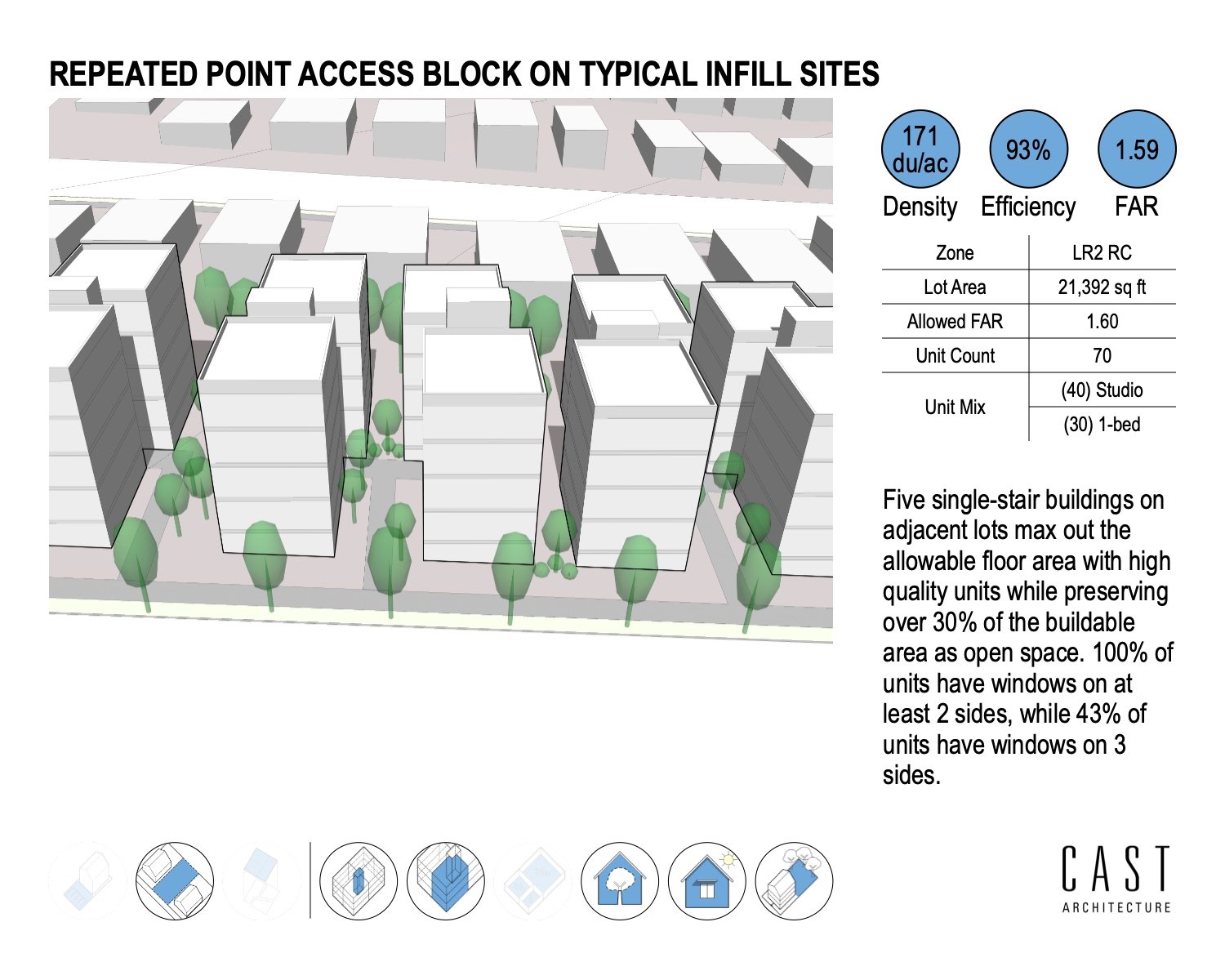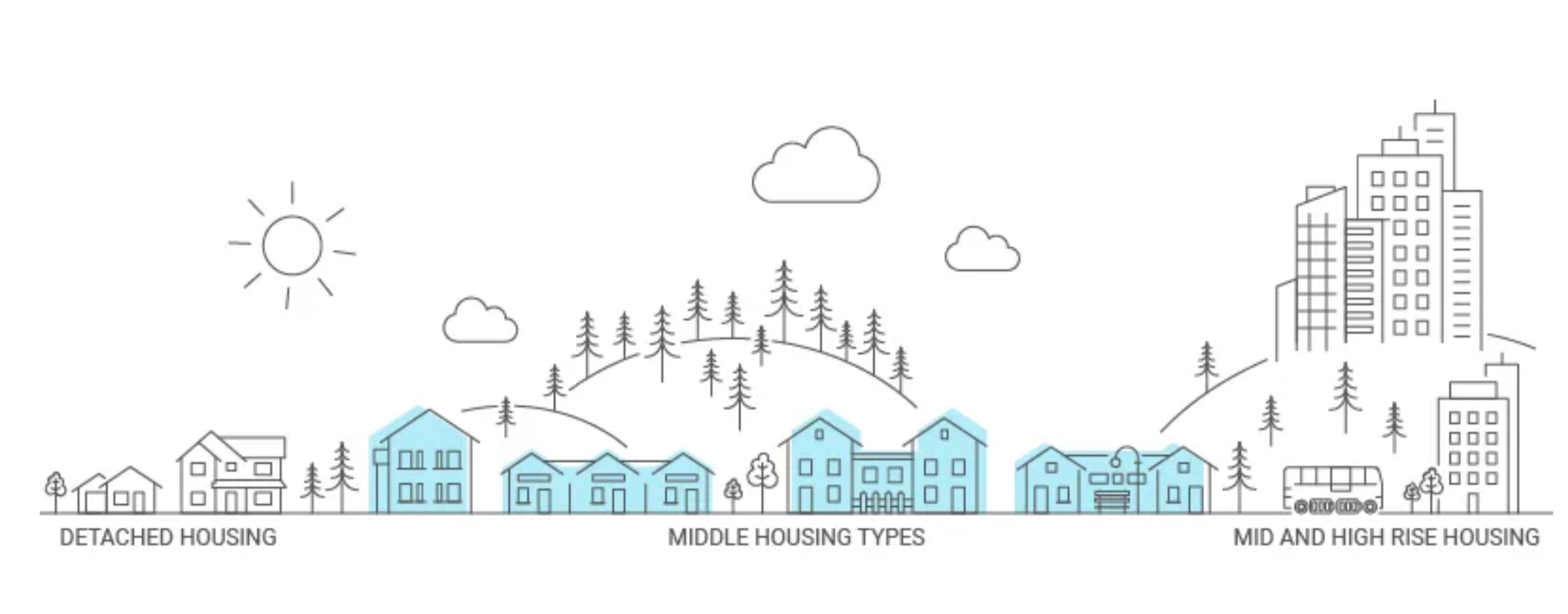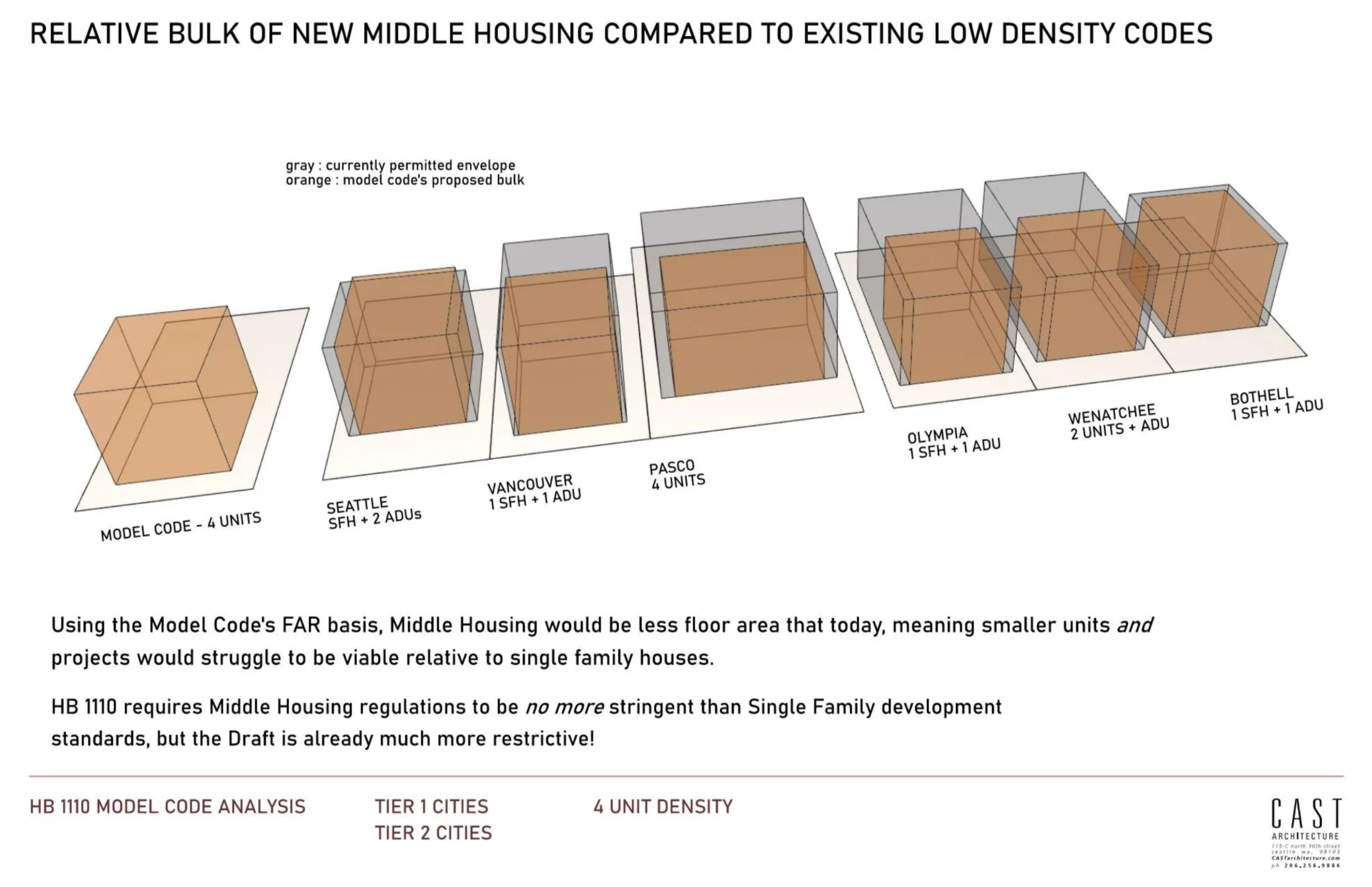Introducing CAST’s Infill Housing Toolkit: We put together recent, current, and future projects to showcase strategies and case studies for abundant housing infill development.
Site Typologies
Constrained Lots
Typical Infill Lots
Large, Assembled Lots
Design Features
Single Stair
Stacked Flats
Low-Energy Design
Low-Carbon Building
Diverse Unit Mix
Open Space
Give Middle Housing a shot!
Matt Hutchins’ comprehensive discussion, at Medium, of the Washington state Model Code for Middle Housing and how we can have it produce more housing in line with HB1110.
In HB 1110, the State Legislature read the will of the people and demanded that we tackle the housing crisis more proactively by allowing Middle Housing in most cities and towns. Washington State Department of Commerce has created a basic zoning template that supersedes local code if town planners balk at updating their own code to comply. The draft version of that Middle Housing Model Code is out for comment (comment here by December 6th!). I have analyzed the real world implications of how it would regulate new housing and how we can tweak it to better support the creation of townhouses, flats, and infill development.
Here are my recommendations:
1. Allow Middle Housing to be larger than single family houses: more lot coverage, smaller setbacks, and make them taller.
Diagram of current allowable single-family building sizes in 6 cities to illustrate that the Model Code’s Floor Area Ratio system is actually more restrictive.
It seems like an obvious point that the bulk of a building or buildings for up to 2, 4 or 6 households might be larger than one with just a single household, but a close look at some of the cities governed by this new legislation reveals that the draft code is MORE restrictive than current codes. It would effectively be a downzone in structure size in order to house more people. That isn’t a good trade, and for all the proof that Middle Housing has wide ranging benefits, we should have a code that supports it.
Middle housing is not just a bridge between the densities of single-family neighborhoods and denser areas, it is also a incremental increase in size between those building types.
2. Measure lot coverage, not FAR
There is a policy conversation about two methods for measuring building size: 1) lot coverage X height vs. 2) lot size X Floor Area Ratio. The draft code uses FAR for Tier 1 and 2 cities (the larger cities and the municipalities around them), and Lot Coverage for Tier 3 cities (smaller cities).
In the six Tier 1/Tier 2 cities I picked to analyze, five use lot coverage not FAR. The model code should follow suite. It is easy to implement, understand and compare apples to apples to existing codes.
Diagram of small cities buildable footprint illustrates how extra flexibility in lot coverage will translate to new housing for those communities.
Meanwhile Tier 3 cities, the code uses lot coverage to provide flexibility for how to develop successful infill housing, because lot coverage isn’t the critical threshold, the market is. I think this part of the Model Code will be actually be good for many smaller jurisdictions that are struggling with housing cost and access.
3. Set thresholds by looking at what can be feasibly built, not what might be politically expedient.
Illustration of all the new building types and whether they would be viable under the draft Model Code for typical lot sizes.
There is often a disconnect between how planners see development standards and how developers implement them. But ground truthing the code, when it is a draft, to understand the inevitable determinative impacts on the housing types that will get built, is the key to making the good development we want to see also the easiest to build.
Using a typical 5000 sf parcel zoned under the new code for 4 units, applying the FAR, we can build 4000sf. It becomes immediately apparent that many of the housing types we’re hoping for will never materialize and other types are going to yield less that then maximum number of units. Of the six types, I would expect the only feasible project is three townhomes. It is unlikely we’d generate very many 1000sf townhouses, 1200 sf triplex units or courtyard apartment buildings under the added cost of the IBC compliance.
The FAR needs to be up between 1 and 1.2 before we’d see the fourth townhome, or an apartment building.
4. Lean into making the most efficient and affordable housing form (small apartment buildings) the default infill Middle Housing type.
Our Spokane Six on the left works today, but wouldn’t be viable under the draft Model Code. This illustration shows that it would need to be 21% smaller.
Small apartment buildings have significant headwinds when it comes to financing, construction and operation. They also are the greenest, most efficient, context friendly and often least expensive forms of housing. They are also the best for preserving usable open space and landscape for large trees. They are the lowest common denominator building block for tackling the housing crisis. If the code works for those, then the other forms, like ownership townhouses, will work too.
When we tested our recent Spokane Grand sixplex, using the new Model Code, we discovered that we’d have to reduce the size by 21%, loose one of the porches, and downgrade the units from family friendly two bedrooms to one bedrooms. The pro forma for the development fell apart. If it can’t work in Spokane, with low land cost, reasonable construction cost, steadily climbing rents, there is very little chance these buildings would be viable in Puget Sound or other Tier 1 and 2 cities.
Without zoning incentives to build apartments, the market will continue to underproduce less expensive rental housing, even if we see some new ownership townhomes.
5. Reduce parking minimums.
Parking is always the cart that drives the horse. We have a housing problem not a parking problem.
So much has already be said and written about the high price of parking mandates, so I’m going to appeal to pure geometry.
On residential lots, designing for parking is step 1, before you even start to conceive of a building. For a sixplex on an alley, where parking is required, one space per unit arranged along the alley would require a lot width 56' feet minimum, which is wider than most urban lots. In order to provide the parking, much of the back yard is overtaken with pavement, more than 1/3rd of the site, lessening the quality of life for residents, creating stormwater issues and additional costs.
Without an alley, it is always worse; more than half of our typical lot is parking or driveway.
6. Regulating aesthetics on small neighborhood buildings is unnecessary micromanagement.
Strike this section. Or don’t. It is really so milquetoast that compliance isn’t an issue, but there will be lots of overlap/conflict with local codes that do regulate these simple aesthetics. Most townhouses are less that 20 feet wide — does a building’s design need to change every time there is a door? It is so fussy. In the interest of less bureaucracy, we should stamp out regulatory creep preemptively.
A Model Code that works.
The State’s Model Code is an opportunity to create a baseline for Middle Housing but it has to work. And this draft code would be so much more effective if it wasn’t second guessing its own mandate.
A final Model Code based on incremental increases of size over current single family structures, lot coverage not FAR, without parking minimums and design prescriptions, which allows builders the flexibility the make the homes people need, is the right direction forward for a statewide standard.
New Sitka Cottage: 3-bedroom DADU
At 1,000 net square feet, the Sitka Cottage features three bedrooms and two baths upstairs, an open living room and kitchen, storage, and an additional powder room tucked away on the first floor. It fits flexibly on many sites with a walk-out terrace off the living room/kitchen. The three bedrooms upstairs are reasonably sized and work well for a family. Standard, wood-frame construction, vented shed roof, slab-on-grade foundation, careful placement of windows, and a simple exterior allow for low-cost construction without sacrificing durability, function, or style.
The design is under the height limit and can fit on standard to small lots, around trees, or on sloped lots, with space for adjacent parking if desired. The cottage can be oriented toward the principal residence for multi-generational living around a courtyard. The front door is on the corner and can be placed on either the short or long side of the design, depending on site orientation.
The design targets 4-Star Built Green, with details for reduced air infiltration, energy-efficient heating, cooling and water heating systems, passive solar heat gain in window/shading in summer, low-VOC finishes, no fossil fuel appliances, and all LED lighting.
See more at CASTcottages.com
Hawthorne Hills Three:
Single-family residence, ADU & DADU
This project renovates an existing home and adds an attached accessory dwelling unit (AADU), and a detached accessory dwelling unit (DADU) to thoughtfully develop this single-family home into three rental units in the desirable Hawthorne Hills neighborhood of Seattle. It brings forward a model of urban density, providing much needed ‘missing middle’ housing. The exterior of the two buildings is unified in onyx-grey fiber cement siding with cedar accent areas. The home is 4-Star BuiltGreen certified.
The main home, with three bedrooms at 1,150SF, is renovated for modern living. The kitchen features three skylights that maximize natural light and brighten the core of the home. The original warm oak floors were refinished and unify the spaces.
The 410SF AADU takes advantage of the original house’s slightly set back position on the lot to build a new unit to the front and side setback. The entry opens to the bright kitchen and living space. Within the compact footprint, a hallway through the utility room leads to the bathroom and a separate bedroom.
The backyard cottage is a 1000SF two-story home. Situated on the lot for privacy, a private walkway leads to the front door. The DADU boasts three bedrooms with vaulted ceilings on the top floor. Downstairs, a generous great room and kitchen with expansive glass doors open to the patio and private backyard. The efficient, open plan and bonus storage add to the versatility of the home.
See more here.
TEAM
Builder: Cadre General Contractors
Civil: Davido Consulting Group/Watershed
Survey: Terrane
Structural Engineer: Owen Gould
GeoTechnical: Cobalt GeoSciences
Andersen Windows & Doors
Photography: Peter Bohler
WA State legislature passes SB 5491 single-stair bill
As we struggle with the construction cost of housing across the state and look to make building middle housing more affordable and abundant, the building code can sometimes add unnecessary complexity without adding any benefit to life safety.
In Seattle for the last fifty years or so, we’ve had a provision for small multifamily buildings that can eliminate one of the two typical stairs under very strict, prescriptive conditions: four units per floor, sprinklered buildings, fire-resistance-rated construction, quick access to a protected exit or to the street. These aren’t high rises or big apartment blocks.
Small apartment buildings should be the building block for middle housing and the single-stair provision makes many more sites feasible and gives architects more flexibility to design great buildings.
We have designed four of these small apartment buildings, varying from four to ten units. The sites are small urban infill, and a second stair would have probably killed the projects. On many infill sites, having a second stairwell means fewer windows for residents, fewer units, less ventilation, more blank exterior walls, and ultimately higher rent for residents because the buildings are much less efficient.
Senate Bill 5491 legalizes single-stair apartment buildings up to six stories. It will require the State Building Code Council (SBCC) to develop recommendations for these buildings and adopt the changes by July 2026.
The SBCC must convene a technical advisory group to recommend modifications and limitations to the International Building Code (IBC) that would allow for a single exit stairway to serve multifamily residential structures up to six stories.
The recommendations must include:
• considerations for adequate and available water supply
• the presence and response time of the fire department
• any other provisions necessary to ensure public health, safety, and general welfare
Six-to-twelve-plexes offer a superior urban experience, more housing units, more housing variety, and at least some fully accessible housing units. They also may preserve more tree canopy, increase open space, and optimize daylight compared to townhomes. These homes will push the bounds of the single-family envelope but maintain an urbanism-friendly street frontage.
As one of the region's leading voices for abundant and affordable housing choices, we advocate for smart density and missing middle housing. More efficient land use is critical to address our housing crisis, climate change, and persistent inequities in access to housing opportunities.
Statewide efforts to boost housing options make headway
This past legislative session, several bills made it through both houses and each will have long term benefits for the production of urban infill housing types such as cottages, ADUs, and small stacked apartment buildings.
HB 1337
The passing of HB 1337 expands housing options by easing barriers to the construction and use of ADUs.
· legalizes two ADUs per lot in any configuration of attached/detached
· legalizes an ADU on any lot size that’s legal for a house
· legalizes ADU size up to at least 1,000 SF
· legalizes ADU height up to 24 feet
· ends requirement for owner to live on site
· caps impact fees at 50% of those charged on houses
· lifts parking mandates within 1/2-mile or 15 minutes from transit stop
· prohibits design standards or other restrictions more stringent than what applies to the main house
· legalizes ADUs to abutting property lines on alleys
· legalizes ADUs in existing structures that violate current rules for setbacks or lot coverage
· prohibits requirements for public right of way improvements
· legalizes the sale of ADUs as condominiums
HB 1110
The Middle Housing Bill will mandate that medium and large cities create development standards for their lowest density zones to accommodate more housing. For Seattle, it means:
· Up to 4 units on any parcel not previously limited by an HOA or PUD.
· Up to 6 units on parcels that are within ½ mile (a 10 minute walk) of frequent or fixed transit
· Up to 6 units on any parcel if 2 are designated as affordable.
The form that these new housing types will be open ended, but the Department of Commerce is busy developing a model code for cities to use as a starting point. The deadline for cities to comply is 6 months after their next comprehensive plan cycle (for Seattle that is mid 2025).
As one of the region's leading voices for abundant and affordable housing choices, we have been advocating for backyard cottages—accessory dwelling units (ADUs)—since Seattle first considered them citywide in 2009.
More efficient land use is critical to address our housing crisis, climate change, and persistent inequities in access to housing opportunities. Modest infill houses like ADUs are a key strategy to empower citizens to provide new housing, build generational wealth, and leverage taxpayers’ investment in infrastructure, transit, schools, and parks.
Jansen Court missing-middle housing in the Capitol Hill neighborhood of Seattle.
Seattle architect designs missing-middle housing
Jansen Court Apartments is a Built Green 4-Star 10-unit studio apartment building on the back of a 30’ parcel in Capitol Hill, preserving a turn-of-the-century house in the front yard.
With a single stair, this 4-story apartment building was quite the puzzle -- the complexity of regulations are magnified on a small project. Each level is different, with a basement, typical story, vaulted story, and unit with roof access. They're small, 400-600 SF, but nicely livable spaces.
And, it’s in Capitol Hill with a pretty street and bustling neighborhood. Walk Score: 92!
CAST is closely associated with efforts to improve housing affordability through increasing the “missing middle” moderate density infill within existing neighborhoods.
Photo credit: @lensit.studio

